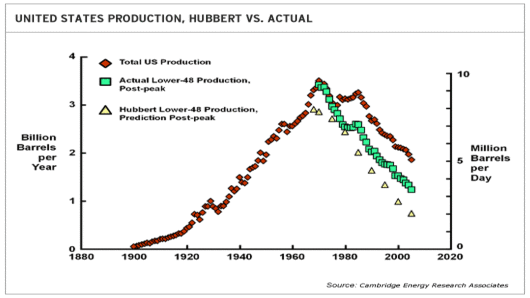Matthew Simmons, who leads an independent, Houston-based investment bank,Simmons & Company,specializing in the energy industry, is the author of "Twilight in the Desert: The Coming Saudi Oil Shock and the World Economy,"which popularized the theory of peak oil, and firmly believes production isn't going any higher.
Michael Lynch, president of Strategic Energy & Economic Consulting, has been a long-time peak oil skeptic.
How were you convinced (either way) about peak oil, and does the recent run-up in oil prices provide evidence confirming or contradicting peak oil?
Simmons: I’m a data nut. I don’t really care what people believe [about oil supplies]. I wrote my book after reading some 200 technical reports about the declining oil fields in Saudi Arabia.
You can line up upwards of 50 to 60 individual oil fields that are of significant size, and they all have that same trajectory. (For instance, Prudhoe Bay, the largest US oil field, maintained peak production — 1.5 million barrels per day — for 11 years but is now down to 200,000 bpd, and within five years will be at 50,000 bpd.) If you look at that, it becomes more and more clear that if we are not at peak oil, we are at a mesa.
Lynch: Peakists predict a peak and it comes and goes, and then they predict a new peak and keep insisting the method is correct. It’s just a little premature. But we see oil production going up and up over time. Over the last 10 to 15 years we have had a number of peaks and declines, followed by new increases in production.
I agree there is cause for concern. There is no question we have seen the worst non-OPEC performance, probably historically ... and this has gone on for about a decade. But I think a lot of that is explainedby the shift of investment money.
How thoroughly has the world been explored, and is it clear that there are very diminished prospects for finding giant elephant fields?
Simmons: The history of finding new basins has generally come towards the end of a very disappointing exploration program and somewhat as a surprise — that’s how we found West Siberia, the North Slope and the North Sea. It took a decade of poking around and then all of sudden — bingo! — they find a producible structure. The problem is that we have been poking around in all the known areas and we have not had a bingo event for a long time. The Saudis have been on a scavenger hunt for 45 years and have found nothing. The closest thing we have had in recent years was the deepwater of the Gulf of Mexico.
Lynch: Almost every year the industry has added about 5 million barrels a day, mostly to cover depletion, so it seems kind of invisible — but that's Ghawar (a Saudi giant field). We are not finding anything like Ghawar, but if you ask people where did you find 25 million in the last five years, most people would not be able identify a fraction of that.
What do you consider the most encouraging discoveries? For instance, how significant is the recent Brazilian off-shore oil find,and what about the US Geological Survey's assessment (shared by the Russian and others) that the Arctic is rich with hydrocarbons? And don’t new explorations advances make discoveries more likely?





